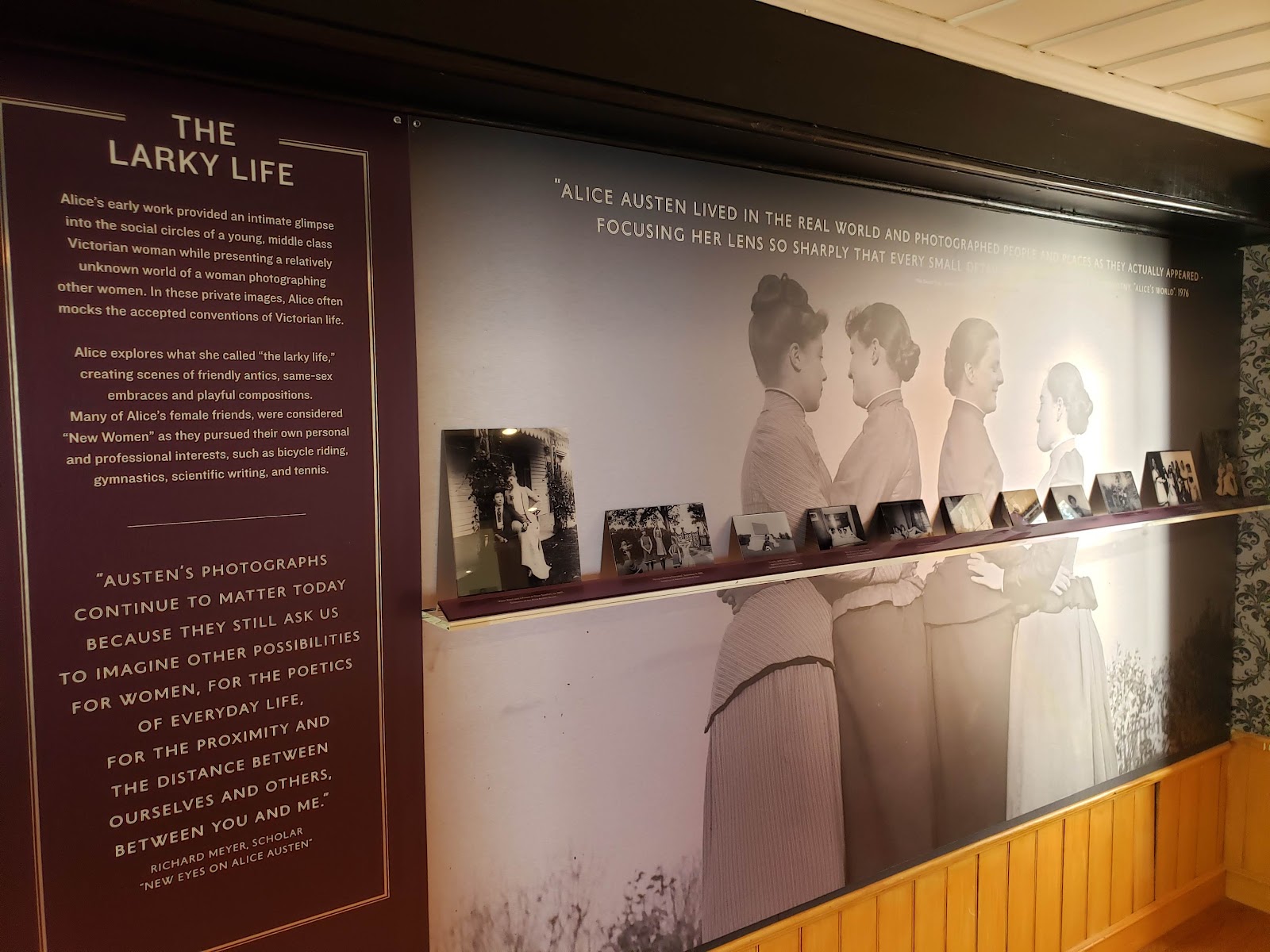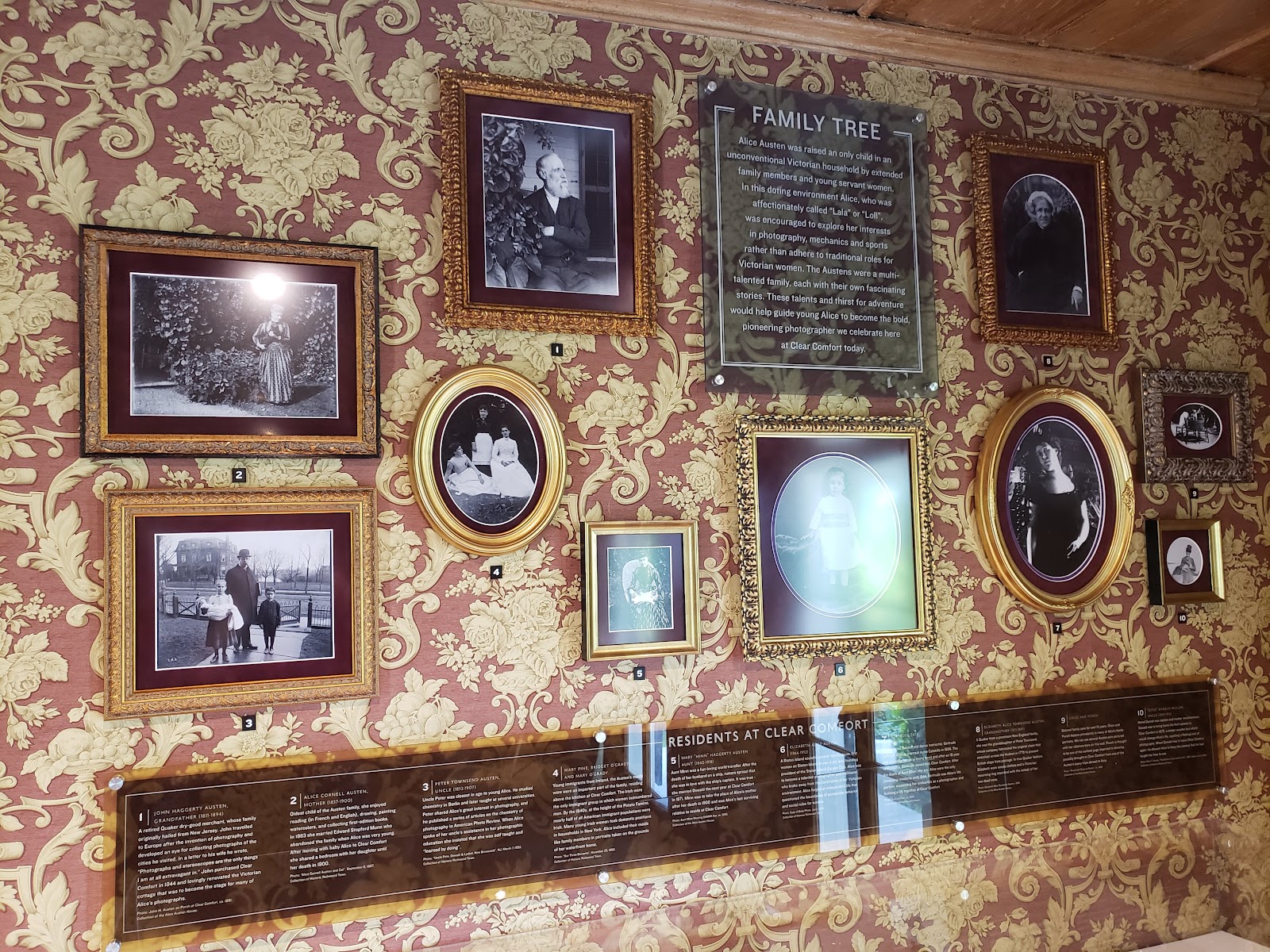The Alice Austen House on Staten Island represents the life and work of Alice Austen (1866-1952), an early American photographer and a woman ahead of her time. She was one of America’s most prolific female photographers and captured over 8,000 images throughout her life. The house was restored to its former glory after years of neglect as interpreted as a traditional historic house museum. In 2015, the museum received a planning grant from the National Endowment for the Humanities to re-interpret the museum to focus more on the life of Alice Austen and in 2017 updated their National Landmark designation to become a National Site of LGBTQ History.

Exhibition panel as part of the new permanent exhibition “New Eyes on Alice Austen”
Photo courtesy Danielle Bennett
“Clear Comfort”
Alice Austen’s home, “Clear Comfort” was built in 1690 as a Dutch Farmhouse. She moved to the house in the late 1860s where she lived with her mother. In 1917, Gertrude Tate moved in and they both lived in the home until 1945 when financial problems forced them out. “Clear Comfort” had been in the Austen family for nearly 100 years. The house fell into neglect and a group of citizens (later the Friends of Alice Austen House, Inc.) successfully saved the house in the 1960s, gained it historic landmark status, and restored the house in the mid 1980s.
When current Executive Director Victoria Munro first visited the house, it was a simple self-guided tour that focused on period furniture placed to replicate the late 19th century. “I didn’t know who Alice Austen was. I only knew that I was visiting a historic house in a park. There were some photographs in the entryway and the rooms were filled with furniture from the time period of the home and there were two contemporary art galleries. But I left not really knowing who Alice Austen was, not knowing that she was a photographer and definitely not knowing that she was a lesbian. As an artist who is gay, that would have been really big for me,” said Victorian Munro, Executive Director.

The “Family Tree” exhibition panel
Photo courtesy Danielle Bennett
Interpretation Changes at the Alice Austen House
Munro first came to the house in 2015 to write programming about women’s history and help create a more structured women’s history program. In 2017, she became the Executive Director. Under her leadership the house received a $250,000 National Endowment for the Humanities (NEH) grant for the implementation of a new onsite interpretation and expanded website content called New Eyes on Alice Austen: Redesigning the Museum’s Permanent Installation. The museum used scholars to help re-envision the permanent exhibition that would incorporate Alice Austen’s contributions to photography, immigration, women’s and LGBTQ history.
Before this grant the house only included 25 photographs from Alice and did not help to tell her story. The scholars brought in as part of the NEH grant helped to create an overarching voice for the museum by using more of Alice’s photographs and life. Scholars helped contextualize Alice Austen in New York City history, women’s history, immigration, LGBTQ history, and photographic history. “We felt like we were finally doing justice for Alice and her story,” said Munro. “As the installation for this new permanent exhibition was forming, the scholars helped us pull together every quote possible on Alice’s work to create an identifying voice for the museum. We unfortunately don’t have her voice. We have notations on her photographs, but by the time Alice was interviews she was in the final years of her life, she was homeless, and wasn’t exactly in a position of power to speak about her younger years.”
The installation of the new permanent exhibition took around two years and used high-resolution photographs and updated text that was recommended by the scholars. The museum no longer displays period furniture, since most of it didn’t belong to the family. Alice’s story was integrated into all educational programming. Victorian Munro reflected that there were times during this transformation where it was difficult to explain to people about the interpretation changes. “We had people who just really loved the Alice Austen House but they were so receptive to what the changed looked like and the new visitor experience. They see how the rooms are interpreted without any furniture but they can move through it, see Alice’s camera, see her work, and it’s an amazing experience.”

Alice Austen’s photographs of what the house looked like when she lived there replace the period furniture. Photo courtesy Danielle Bennett
The Alice Austen House expanded their mission to include “exploring personal identity” to help highlight LGBTQ interpretation and other programming. Photographs of Alice’s partner Gertrude were hung on the walls of photographs and when the house was designated an LGBTQ Historic Site in 2017, a new introductory text panel was installed in the museum entrance that acknowledges the 53-year relationship between Alice Austen and Gertrude Tate. This reinserted Gertrude as a central figure in Alice’s life and including her into the physical space of the house.
Content Inclusion
“In accepting the amendment to our national designation, it gave us a huge responsiblity to the LGBTQ community, to actively program for them, and also provide inclusive programming for everyone else because it’s everyone’s history,” said Munro. Since the new installation of the permanent exhibition and new designation as an LGBTQ Historic Site, visitorship has doubled. “We have had visitors that have been here before and come back and have been so overwhelmed, especially if they are part of the LGBTQ community. They are so moved to see Alice and Gertrude’s relationship included in our narrative, to see Gertrude included on the family tree.”
Historian Danielle Bennet who worked at the Alice Austen House as Visitor Experience & Social Media Manager during its transformative time said, “If you open your house to a story that’s about differences, you not only embrace that particular difference but you end up becoming more open to exploring others and embracing the community however it comes. I think it makes a museum more open and vulnerable as an institution.” Bennett commented that the Alice Austen House is now much more robust in its new permanent exhibition and by sharing the story of Alice and Gertrude, the house is providing more inclusive content to its visitors.
Interpreting Queer History
“I’ve found that sometimes museums know what they have in the collection, object wise, but going back to read the content within the collection, the letters, diaries...and to look at this content with fresh eyes to see what’s there,” said Bennet. “There are probably some really interesting pieces awaiting uncovering and interpretation. “I ask people to grapple with uncertainty. As historians were never going to know exactly how things were like. We can make best guesses and its harder to make a guess about queerness and transness because it has been scrubbed from the record but if you find something there, the odds are actually probably pretty good that there’s a reason why something persisted to present day.”
As historic house museum tell the stories about the other people who lived there and wonder how to best interpret queer history, Bennett suggests looking at the history with a bigger lens. “Houses need to talk about the other people who lived there, the other people who were closest to the houses’ namesake. Their stories are going to have something interesting. [Museums] need to ask who counts here? Are you only counting people who have certain kinds of privilege? If someone who lived in these spaces seems like they were queer, does that make their story count less?” Bennett also suggests from her research and experience working with historic houses is to create and work with community panels or advisory groups from people who know the topic, a queer academic or a queer person with a similar life experience. “People from a certain group can see things that staff might not see and it’s useful to bring in people with different viewpoints, especially when interpreting queer history.”
------------
About the Alice Austen House
The Alice Austen House is a New York City and National Landmark, on the Register of Historic Places and a member of the National Trust for Historic Preservation’s distinctive group of Historic Artists’ Homes and Studios. In June 2017, the Alice Austen House, where Austen and her life partner, Gertrude Tate, lived together for nearly 30 years, marked its national designation as a site of LGBTQ history and updated their designation to become a National Site of LGBTQ History. This was an achievement of the NYC LGBT Historic Sites Project, funded through a grant from the New York State Historic Preservation Office and made possible by the National Park Service.
Further Reading
Alice Austen House
https://aliceausten.org/
LGBTQ Heritage
https://www.nps.gov/subjects/tellingallamericansstories/lgbtqheritage.htm
NYC LGBT Historic Sites Project
https://www.nyclgbtsites.org/
Visit the newly redesigned Alice Austen House and celebrate its rich history and innovative events
https://www.neh.gov/news/visit-newly-redesigned-alice-austen-house-and-celebrate-its-rich-history-and-innovative-events
Danielle Bennett, Historian and Museum Professional
http://daniellebennett.nyc/
